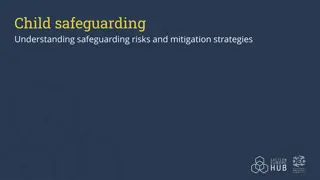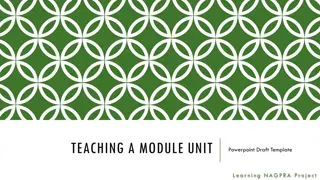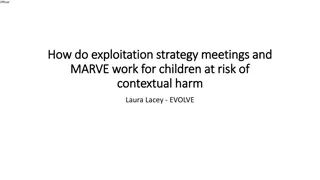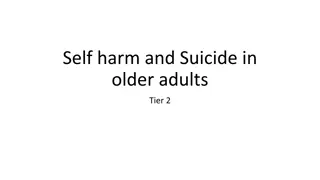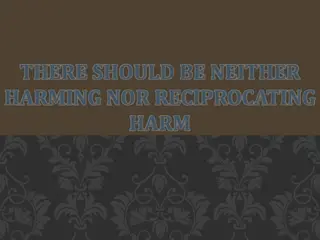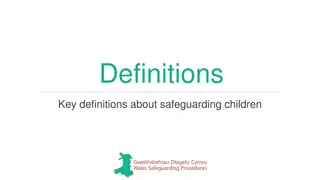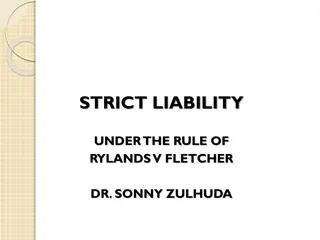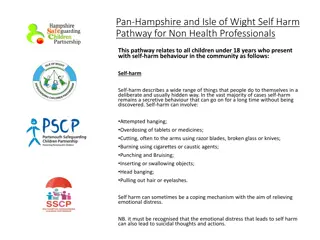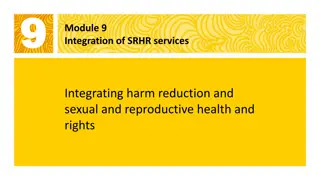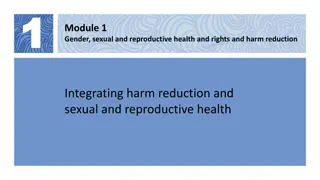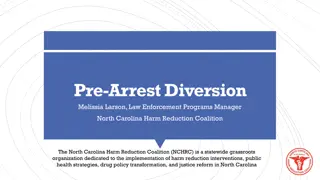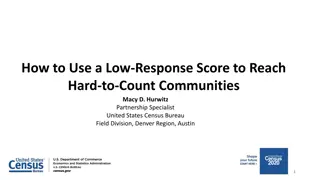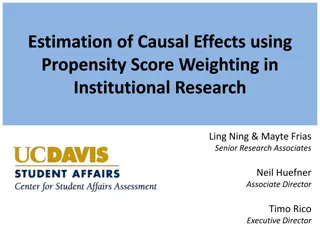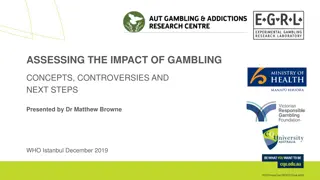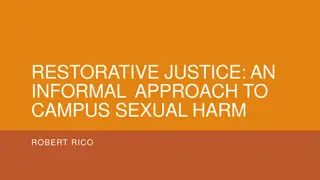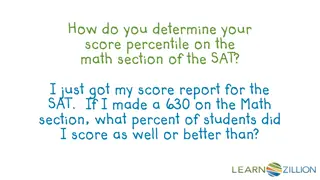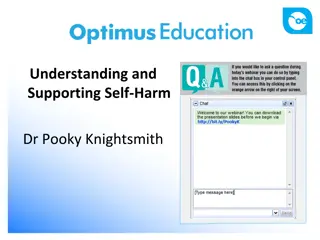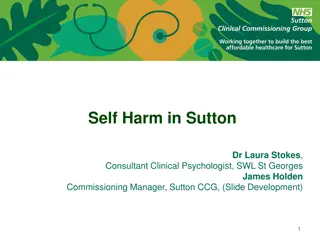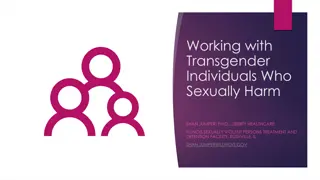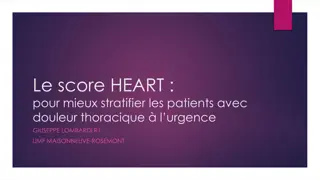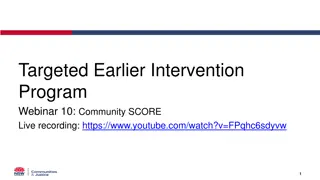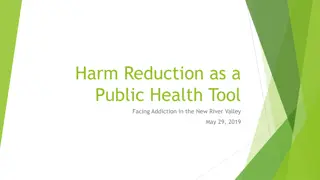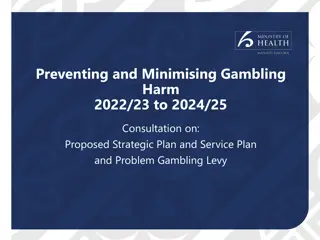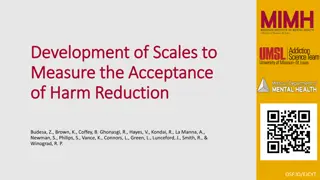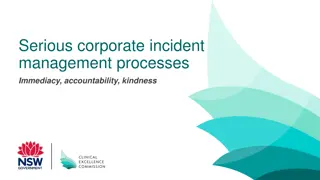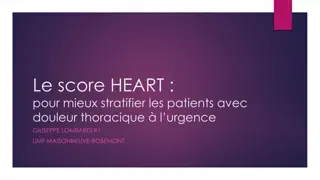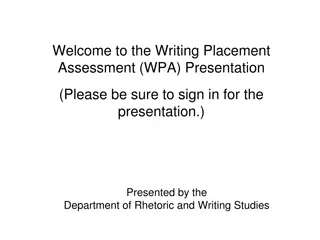The Power of Collaboration in Harm Reduction and Public Safety Partnerships
Learn about successful collaborations in harm reduction and public safety to prevent overdose, featuring insights from various presenters and an overview of pilot projects supported by the National Council and CDC. The webinar emphasizes evidence-based strategies, integration of harm reduction and p
1 views • 31 slides
ECC Social Value Reporting and Evaluation Framework
Essex County Council (ECC) has implemented a robust Social Value Reporting and Evaluation framework based on the Local Government Association's National TOMs method. This framework categorizes and assesses social value contributions in two parts - Value Score and Supporting Statement Score - to deri
3 views • 16 slides
The Truth Revealed Does Cannabis Harm Brain Cells.docx
The Truth Revealed: Does Cannabis Harm Brain Cells?\nIn recent years, the debate surrounding the effects of cannabis on brain health has intensified. With the growing popularity of cannabis and the increasing accessibility of products from online weed dispensaries and marijuana dispensaries, it\u201
9 views • 3 slides
Understanding Significant Harm in Child Protection Cases
In child protection cases, significant harm must be proven for court intervention. Harm can include ill-treatment or impaired health and development. The state may intervene if necessary, but diverse parenting standards are tolerated. Evidence-based findings are crucial, and local authorities must p
0 views • 11 slides
Understanding Child Safeguarding Risks and Mitigation Strategies
Understanding child safeguarding risks and mitigation strategies is crucial for organizations to prevent harm to children. This includes identifying who in an organization has contact with children, understanding different forms of abuse, and implementing safeguarding measures. Safeguarding involves
0 views • 34 slides
Exploring the Ethics of Do No Harm in Research and Practice
Delve into the profound concept of "Do No Harm" as it relates to bioethics, research, and medical practice. Examine the historical origins of this principle, differing perspectives on harm, and the implications of non-maleficence in research settings. Gain a comprehensive understanding of the Nuremb
1 views • 15 slides
Harm Reduction in Addiction Psychiatry: A Comprehensive Overview
Harm reduction in addiction psychiatry is a client-centered approach that focuses on reducing negative consequences associated with substance use. This philosophy involves practical strategies and principles aimed at promoting safer drug use practices. The historical background traces the evolution
1 views • 40 slides
Understanding Exploitation Strategy Meetings and MARVE for Children at Risk of Contextual Harm
To address concerns of extra familial harm affecting children and young people, this session delves into exploitation strategy meetings and MARVE intervention. Learn about making effective referrals, identifying risks, and when to convene strategy meetings to safeguard vulnerable individuals from ha
1 views • 25 slides
Understanding Self-Harm and Suicide in Older Adults
Self-harm and suicide in older adults are serious issues that require attention due to the associated risks. The incidence of self-harm in adults aged 65 years and older is notable, with factors such as physical health conditions, pain, and psychiatric history contributing to the risk. Staff should
0 views • 23 slides
The Significance of Avoiding Harm in Islam
This content delves into the noble hadith emphasizing the prevention of harm in society, exploring Islamic teachings on unintentional harm, and the importance of refraining from causing harm to oneself or others. Discussions on Islamic law, societal implications, and practical solutions highlight th
0 views • 14 slides
Understanding Self-Harm and Suicide in Older Adults
Exploring the definition, risk factors, incidence rates, and staff approaches related to self-harm and suicide in older adults. It emphasizes the seriousness of self-harm in this demographic, the associated risk factors, and the importance of responding with compassion and support. The content delve
0 views • 21 slides
Understanding Safeguarding Children and Child Protection
Safeguarding children involves taking proactive measures to promote their well-being and protect them from harm, including abuse and neglect. Child protection focuses on identifying and responding to children who are at risk of significant harm. Different types of harm, such as physical, sexual, emo
0 views • 24 slides
Strict Liability under the Rule of Rylands v. Fletcher
Strict liability under the rule of Rylands v. Fletcher establishes that a person who brings something onto their land that is likely to cause harm if it escapes is responsible for any resulting damage, regardless of negligence. The case of Rylands v. Fletcher (1868) set the precedent for this doctri
0 views • 17 slides
Pan-Hampshire & Isle of Wight Self-Harm Pathway for Non-Health Professionals
This pathway provides guidance for children under 18 presenting with self-harm behaviors, including definitions, risk scenarios, suggested responses, and further considerations for urgent medical and psychological support in self-harm cases. It covers various types of self-harm, levels of risk, and
0 views • 5 slides
Integrating Harm Reduction and SRHR Services for Women and Gender Non-Conforming People Who Use Drugs
This module focuses on integrating harm reduction and sexual and reproductive health and rights (SRHR) services for women and gender non-conforming individuals who use drugs. It aims to identify gaps in service provision, map appropriate client-oriented SRHR services, and develop action plans to imp
0 views • 10 slides
Top 5 Ways to Improve Your CIBIL Score
In addition to determining whether you will be able to get a loan, your CIBIL score will determine how much interest you will pay. Your money depends on you taking care of it . If your score is high, some lenders may be more likely to lend you money.
11 views • 3 slides
Understanding Gender, Sexual Health, and Harm Reduction
Explore the intersection of gender norms, sexual and reproductive health, and harm reduction in Module 1. Learn about the impacts of gender inequality, stereotypes, and the importance of integrating SRHR services into harm reduction programs. Engage in activities to challenge traditional gender role
0 views • 21 slides
Effective Score Marking Process for Music Study
Explore the comprehensive process of score marking for music study, covering essential components like musical, technical, historical needs, and the values associated with good literature. Learn about composer composition, graph analysis, and the importance of efficient score marking to enhance your
0 views • 13 slides
Understanding Self-Harm and Suicide in Older Adults
Self-harm and suicide in older adults present unique challenges due to factors like underreporting and stigma. The incidence of self-harm in this age group is significant, with specific risk factors and warning signs to consider. Proper staff approaches and preventative strategies are crucial in add
1 views • 23 slides
GLMHC/SCORE Jail Program: Providing Services for City of Tacoma Residents
GLMHC/SCORE Jail Program offers court-ordered assessments and transition services for City of Tacoma residents sent to the SCORE jail. Learn about its background, the purpose of SCORE, mental health services provided, and the collaboration efforts to address gaps in service provision.
0 views • 21 slides
Implementing LEAD Program for Pre-Arrest Diversion in North Carolina
North Carolina Harm Reduction Coalition (NCHRC) implements harm reduction interventions, public health strategies, and justice reform through programs like LEAD (Law Enforcement Assisted Diversion). LEAD diverts low-level drug offenders and sex workers to treatment instead of the traditional crimina
0 views • 7 slides
Strategies for Reaching Hard-to-Count Communities Using Low-Response Score
Explore how to leverage a low-response score to engage with hard-to-count communities effectively. Learn about ROAM mapping tool, the 2020 Census goal, and the significance of Low Response Score (LRS) in identifying areas for targeted outreach. Discover hard-to-count variables and how to utilize dat
0 views • 14 slides
Understanding Self Harm: Exploring the Impact and Coping Strategies
Self-harm, a complex behavior not limited to mental illness, is a way individuals cope with distress. The behavior ranges from smoking to life-threatening actions like overdosing. It affects a significant number of young people, with a notable increase in treatment for deliberate self-harm cases. De
0 views • 30 slides
Estimation of Causal Effects using Propensity Score Weighting
Understanding causal effects through methods like propensity score weighting is crucial in institutional research. This approach helps in estimating the impact of various interventions, such as a writing program, by distinguishing causation from correlation. The use of propensity score matching aids
0 views • 22 slides
Understanding the Impact of Gambling: Concepts, Controversies, and Next Steps
Dr. Matthew Browne's presentation in Istanbul in December 2019 discussed the theoretical framework, burden of harm projects in Australia and New Zealand, current work, and conclusions related to the adverse consequences of gambling on health and well-being. Focus areas included harm distribution, ta
0 views • 18 slides
Exploring Restorative Justice in Addressing Campus Sexual Harm
Restorative justice offers an informal approach to addressing campus sexual harm by involving harmed parties, offenders, and others in a collaborative decision-making process. It focuses on holding responsible parties accountable, repairing harm, rebuilding trust, and addressing underlying issues th
0 views • 20 slides
Understanding SAT Math Score Percentiles
Learn how to determine your score percentile on the math section of the SAT by using a normal distribution curve to find where your score falls relative to other students. Discover the concept of percentiles and how they reflect your position in relation to the mean and standard deviations of the sc
0 views • 39 slides
Understanding and Supporting Self-Harm - Insights and Guidance
Discover the various types of self-harm behaviors, reasons behind self-harming tendencies, common triggers, and practical ways to respond and offer support. Gain insights into the negative emotions and cycles associated with self-harm and understand why individuals may engage in such actions.
0 views • 32 slides
Self-Harm Trends and Factors in Sutton
The data presented in the slides highlight concerning trends in self-harm rates, particularly among young girls, in Sutton. Key issues such as peer pressure, suicidal thoughts, exam pressure, and mental health challenges are identified. Factors contributing to high self-harm rates are discussed, inc
0 views • 14 slides
Understanding Opioid Epidemic Impact & Harm Reduction in Michigan
The Michigan Emergency Department Improvement Collaborative (MEDIC) works to improve emergency care quality, with a focus on opioid overdose. Over 3,000 Michiganders died from opioid overdose in 2021, exceeding motor vehicle-related deaths. Harm reduction strategies, like distributing naloxone in ED
0 views • 10 slides
Understanding and Working with Transgender Individuals Who Sexually Harm
Explore the complexities of addressing sexual harm in transgender populations, learning objectives include understanding transgender experiences, treatment standards, and DSM-V diagnostic criteria for Gender Identity Disorder. Delve into issues like sexual harm, gender dysphoria, and personal biases
0 views • 53 slides
Heart Score for Improved Risk Stratification in Patients with Chest Pain
Heart Score is a valuable tool for stratifying patients with chest pain in the emergency setting, aiding in clinical decision-making. This algorithm helps differentiate causes of thoracic pain effectively, minimizing false negatives and reducing unnecessary hospital admissions. By assessing factors
0 views • 30 slides
Community SCORE - Outcomes Reporting Webinar
Explore the Community SCORE outcomes reporting tool in this insightful webinar. Learn how to effectively utilize Community SCORE for reporting client outcomes and satisfaction, benefiting individuals, groups, and communities. Discover the importance of measuring client outcomes and how it can enhanc
0 views • 30 slides
Utilizing Harm Reduction for Addressing Addiction in New River Valley
In this presentation, Michael E. Kilkenny discusses the importance of harm reduction as a public health tool in combating addiction issues in the New River Valley. The talk highlights the benefits of harm reduction, components of successful implementation, and measures of program success. It also ad
0 views • 20 slides
Consultation on Preventing and Minimising Gambling Harm 2022-2025 Strategic Plan and Levy Proposal
The consultation focuses on the proposed strategic plan and service plan to prevent and minimize gambling harm from 2022 to 2025. It covers the context of gambling harm, the Gambling Act requirements, problem gambling levy, and the assessment of gambling harm needs. Key points include the definition
0 views • 29 slides
Development and Evaluation of Harm Reduction Acceptance Scales
Development of scales to measure the acceptance of harm reduction is crucial for understanding public attitudes towards harm reduction strategies. This project focuses on creating valid and reliable scales through a systematic process involving item development, data collection, analysis, and refine
0 views • 15 slides
Corporate Incident Management Processes and Policy Update
Explore the corporate incident management processes and policy updates focusing on immediacy, accountability, and kindness. Learn about incidents, harm scores, and revised process steps outlined by the Clinical Excellence Commission and NSW Health. Discover the differences between the current and re
0 views • 17 slides
Understanding the HEART Score for Risk Stratification in Patients with Chest Pain
The HEART score is a valuable tool for stratifying patients presenting with chest pain in the emergency department. It helps in distinguishing between low, intermediate, and high-risk individuals and guides further management decisions. By incorporating factors like history, ECG findings, age, risk
0 views • 30 slides
Understanding SDSU's Writing Placement Assessment (WPA)
SDSU's GWAR, an argument-based Writing Placement Assessment, requires students to write an essay analyzing a given argument. Scores range from 2-10, with different score bands dictating course requirements. Achieving a perfect score is subjective, emphasizing clear and concise argument analysis. Som
0 views • 35 slides
Advanced Applications of Monte Carlo Wind Probability Model in Hurricane Analysis
Update on the Year 1 Joint Hurricane Testbed Project, focusing on the Monte Carlo Wind Probability Model and its estimation of wind probabilities for different intensities. The model incorporates track and intensity error distributions, land proximity, and serial correlations to provide accurate for
0 views • 23 slides




